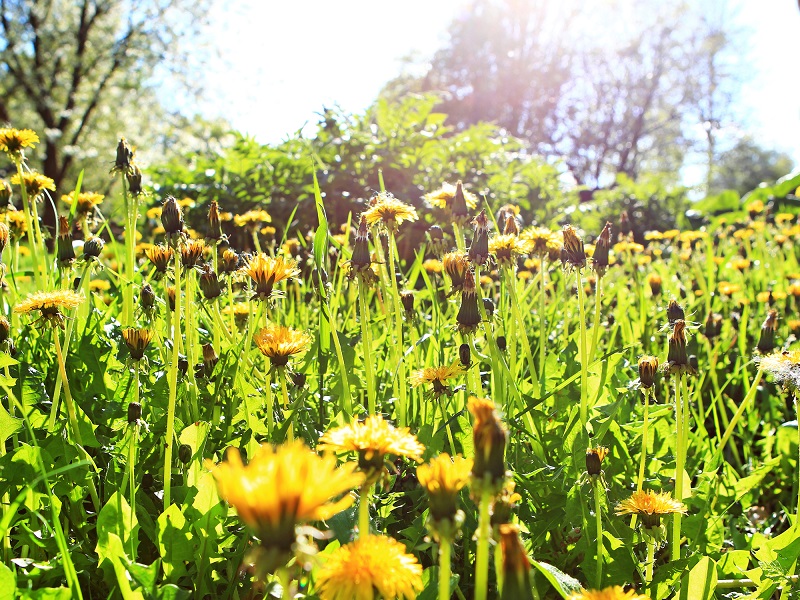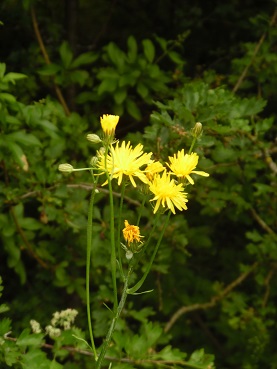 Dandelion root is one of the more popular herbal remedies for acne, and it’s pretty easy to understand the appeal.
Dandelion root is one of the more popular herbal remedies for acne, and it’s pretty easy to understand the appeal.
After all, it’s a ubiquitous plant around the globe, which could be in your garden or local field at this very moment. If you live in a village, then you might be walking past the cure for acne every day, if the theories are correct.
Its main power is widely stated to be detoxification, whether it’s cleansing blood impurities or preventing toxins from being funnelled from the liver to your skin and causing a shocking acne outbreak.
Traditional Chinese medicine believed in dandelion root for “cooling the blood”, in addition to increasing a mother’s milk flow. You can buy dandelion root extract as an herbal supplement, but health gurus commonly advocate a tea form, sometimes as a coffee alternative.
Usually, the word detoxification alone is a good reason to be suspicious of a supplement. In acne land and the world of health, “detox” has evolved into a classic marketing buzzword to make anything seem natural and pure. Chlorophyll is a classic fake supplement which claims to detoxify the body.
However, dandelion root does have some detoxification powers, and they may be useful for acne.
Dandelion root increases glutathione levels
The beliefs of the Chinese and Native Americans, and indeed the beliefs of today, may stem back to one thing. A power to increase glutathione, an antioxidant made by the human body which also functions as a blood purifier. Dandelion root may be similar to milk thistle, another wildly popular detox herb which turned out to work through glutathione:
STUDY ONE – this study gathered 28 male rabbits and divided them into 1) a normal diet group, 2) a high cholesterol diet group, 3) a cholesterol plus dandelion leaf group, and 4) a cholesterol plus dandelion root group.
Read Annihilate Your Acne – get the greatest diet ever for clear and radiant skin
Both dandelion leaf and dandelion root increased glutathione peroxidase significantly, the antioxidant form of glutathione, with the root being even stronger. Levels of free radicals and oxidative stress in the rabbits fell significantly.
STUDY TWO – scientists gave a group of mice the hepatoxic chemical carbon tetrachloride (study). This altered their liver enzymes for the worse, and significantly decreased glutathione levels and increased lipid peroxides (a type of free radical), but a Taraxacum officinale (dandelion) extract reversed both of the changes.
Two forms were tested; an ethanol extract of the whole dandelion root, and an extract enriched with sesquiterpene lactones, plant compounds found in dandelion root. Both performed well, but the latter was particularly effective, hinting that these compounds were behind the mystical detox powers.
STUDY THREE – this mouse study dealt with real world benefits, showing that dandelion root could protect against the glutathione depletion and liver damage of alcohol consumption.
Glutathione-S-transferase, glutathione peroxidase, glutathione reductase, and glutathione all increased, while malondialdehyde, a classic indicator of bodily free radical levels, fell substantially. They concluded that “T. officinale root has protective action against alcohol-induced toxicity in the liver“.
STUDY FOUR – this study was similar, but for painkillers. An ethanol extract of dandelion root was fed to rats whose livers had been damaged by paracetamol. Their glutathione levels were restored, and the dandelion even prevented detrimental changes in the liver tissues.
Here we have a glut of data showing real detox powers from dandelion root, which probably come from elevated glutathione formation.
How does dandelion root benefit acne?
 It’s pretty simple – glutathione is one of the most overlooked compounds for acne in existence.
It’s pretty simple – glutathione is one of the most overlooked compounds for acne in existence.
Few acne patients focus on glutathione, but this study found 20% less glutathione in acne-prone skin compared to acne-free skin. It’s the master antioxidant of the human body, and it deactivates a very wide variety of free radicals. If dandelion root can increase glutathione levels, then that alone is promising for acne.
In particular, there are two key forms of glutathione, which are glutathione peroxidase (GpX) and glutathione-s-transferase (GST). The former is a potent antioxidant, while the latter is the master of detoxification, removing acne-causing chemicals and heavy metals from the bloodstream.
Next: the 6 vitamins and minerals which can massively reduce acne
If our theory is accurate, than dandelion root would protect you from pesticides, heavy metals in apple juice and cigarettes, toxic tap water with a weird aftertaste, and much more. Your acne defences might strengthen substantially.
Make no mistake that dandelion root is far from a scam supplement. Unlike chlorophyll, there’s some decent science behind it.
The chinks in the armour
But how solid is the science – is it strong enough to actually recommend dandelion root?
The answer is no, because none of the eye-catching studies were conducted on humans. The rabbit study observed a significant increase in glutathione, but rabbits are the mascot of herbivores. They spend all day running through grassy fields and woodlands, finding small plants and flowers to eat. Dandelions are a classic food in their evolutionary niche, one whose nutrition would have a disproportionate effect.
With humans, the increase in glutathione could be far more limited. We can eat dandelions, sure, but we’re omnivores, not herbivores, and the benefits from a single flower root could be far less dramatic.
Rats are closer to humans biologically, but not identical; the benefit of rat studies is to back up human studies. In the rabbit study, the detox form GST actually fell; only glutathione peroxidase increased. In the alcohol study, both forms increased. The results are a big mess of confusion and inconsistency.
At first glance, it’s exciting to see alcohol and paracetamol protection; you might think that you have the secret to unlimited beer within your grasp.
However, the rats and mice had defences which were severely depleted. The average 15 year old acne patient has below average glutathione levels, but not compared to a guy in hospital overnight from alcohol poisoning. The increases may be nowhere near as strong in a moderately healthy adult or teenager.
The 7 greatest topical treatments for naturally clear skin
Dandelion root also falls short compared to other glutathione-boosting herbs. Milk thistle, for example, was demonstrated in this study to increase glutathione levels by 271% after eight weeks, in humans. It was shown to reduce acne by 50% in the same timeframe. Dandelion root lacks any studies on humans or on acne directly.
On the ground acne reports
What do the testimonials say? Most are mixed or even negative. I haven’t seen any amazing reports of acne reductions.
There are tales of acne outbreaks, in addition to red rashes. Some attribute the breakouts to a “healing crisis” which must be battled through, a purging period during which the dandelion root successfully removes stored toxins. Once this period is over, your skin will be truly clear, and you just have to endure it.
The healing crisis theory is commonly brought up in testimonials for herbal supplements, but it’s usually a complete myth. The purging period is simply a way for people to maintain hope when the remedy they’ve invested their time into doesn’t work. That’s the reality of the situation.
Your body often stores toxins which it fails to metabolise in adipose tissues, or fat tissues. The liver itself doesn’t store toxins; it manufactures detoxification agents and processes the toxins.
There’s a slight chance that once your glutathione levels have increased (if dandelion root does increase them), your fat tissues could release the stored toxins as they sense the increased detoxification capacity, creating a fresh burst of inflammation. However, the famous silymarin study has clear evidence against.
Milk thistle and its signature compound silymarin are proven to increase glutathione production in the liver, and this study gave acne patients silymarin for 8 long weeks. At each 2 week interval, the decreases in acne were 18%, 26%, 40% and 50% respectively. There’s no sign of any healing crisis at all.
If dandelion root clears your acne, then excellent. If it worsens your skin, then switch to something else and stop losing valuable time. It’s not worth battling through – there’s no promised land waiting (probably).
The real niche of dandelions – free acne nutrition!
In the 21st century, 90% of the money Americans spend on foods is on processed foods. The remaining ten percent is spent on healthy foods like carrots or almonds.
However, even those foods are commercial, cultivated crops. They are distant from the raw ancestor species which humans planted thousands of years ago. Bananas originally had seeds, wild apples are far smaller than those in professional orchards. The most nutritious foods on Earth are ones which produce their own antioxidants and nutrients to fend against the elements, and dandelions fit the bill perfectly.
Dandelions contain 7 times more phytonutrients than spinach. They’re rich in acne-clearing carotenoid antioxidants such as lutein, zeaxanthin and cryptoxanthin. They have four times as much beta carotene as broccoli, and their vitamin A count per 100 grams is even higher than sweet potatoes – 338% of the RDA versus 283%.
Dandelions are a great source of inulin, an insoluble fiber which enriches and diversifies healthy gut flora. There’s also two unique antioxidant compounds with a bitter flavour called taraxacin and taracerin. Taraxicin is known to be a diuretic, but its other powers remain unresearched. You could turn yourself into a human test subject.
Important knowledge – why common vegetable oils are pure evil for acne
The biggest benefit is that dandelions are completely free. If you live rurally then they’re everywhere; you can pick them at will, and easily add them to an acne-friendly meal by steaming them for 5 minutes.
Dandelions rank alongside blackberries as one of the greatest free acne remedies. They’re one of the top secret hacks for clear skin.
If some guy sees you picking all the dandelions in the meadow and declares you to be the village idiot, sit back and laugh as your skin clears and nobody can work out why. Don’t waste your time pulling up the dandelion root and distilling it into a tea like some people recommend. Just eat the whole flower – the stem, leaves, and petals are all edible. Judging by the studies I’ve seen, the root is one of the less nutritious parts.
Conclusion
Dandelions are an excellent plant for acne, but taking the root as a supplement should never be your focus. The glutathione-boosting powers might exist, but they’re not proven in humans, and they’re nowhere near proven to clear acne.
Perhaps you’ve discovered that you’re breathing in too much air pollution, or absorbing too many chemicals in makeup. Maybe you’ve read that in addition to dead skin cells, household dust is filled with toxic chemicals like phthalates from fabrics and plastics (it often is).
In those cases, you should cover the basics of glutathione optimisation first, namely the minerals zinc, magnesium, and selenium.
For a bonus herbal acne supplement, milk thistle beats dandelion root with ease.
NEXT: the ultimate diet for clearing acne permanently
Thanks for reading!

When you detoxify, the harmful toxins in your body is being flushed out. It is important to do so in order to avoid health problems. Detoxifying using natural ingredients just like dandelion can do great works for you.